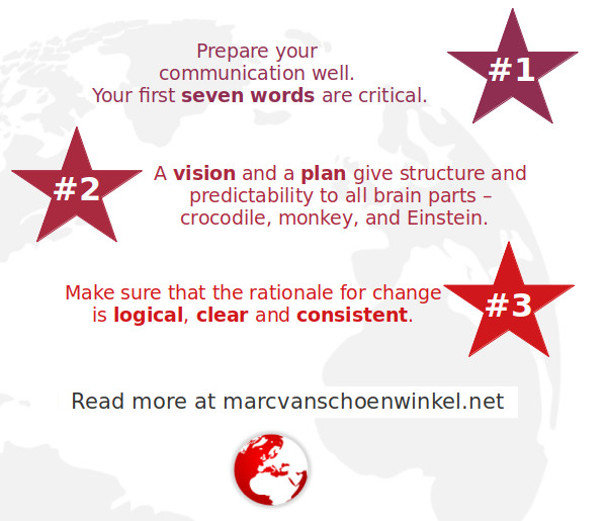Insight from new research on the workings of our brain is crucial to becoming an effective leader, and building productive, happy organizations.
In this article, we give three practical leadership tips to make sure that you lead in a brain-friendly way with a higher success rate.
1. Prepare your communication well.
The first seven words you use need to make the crocodile and the monkey curious without putting them into fight, flight, freeze or flock mode. Unless this is a crucial and/or necessary part of your strategy and you have a well-thought-out plan to handle this).
The latter can be a strategy when you feel that you first have to awaken the crocodile and the monkey to get some movement and that this is only possible by shocking them.

2. A vision and a plan give structure and predictability to all brain parts.
Although a vision and plan seem to be mostly an issue for the rational brain, they also offer structure and predictability to the monkey and the crocodile.
However, in order for this to be the case, the vision has to include honest, positive intentions for the group and individuals (we are striving for a future which is in the best interests of all or most of us).
Also, I do not believe that a plan needs to be detailed (as a highly detailed plan makes no sense in these rapidly changing times), but it must show the actions and safety nets that are in place to address any threats to people on all the three levels:
- Crocodile: What we will do if your territory is in danger.
- Monkey: What we will do to make sure that we stay connected and emotions are acknowledged–whatever happens.
- Rational: What we will do if changes are not compatible with core beliefs and values.

3. Make sure that the rationale for change is logical, clear and consistent.
Use facts, numbers and descriptive examples to illustrate what needs to change. Avoid adjectives at all costs, e.g. “we (read: you) have to become more pro-active, creative, client-focused,” etc.
Frankly, these words have no meaning and are a real status crusher for the emotional brain. With one word you can trigger resistance in the emotional brain. In a fraction of a second you label people as not being pro-active, creative, and so on. They do not know what you mean, but they are still angry.

In my next post for this series, I’ll give three more tips from the Leadership Compass. You can also learn more about Compassion to Lead’s Leadership Essentials here.
